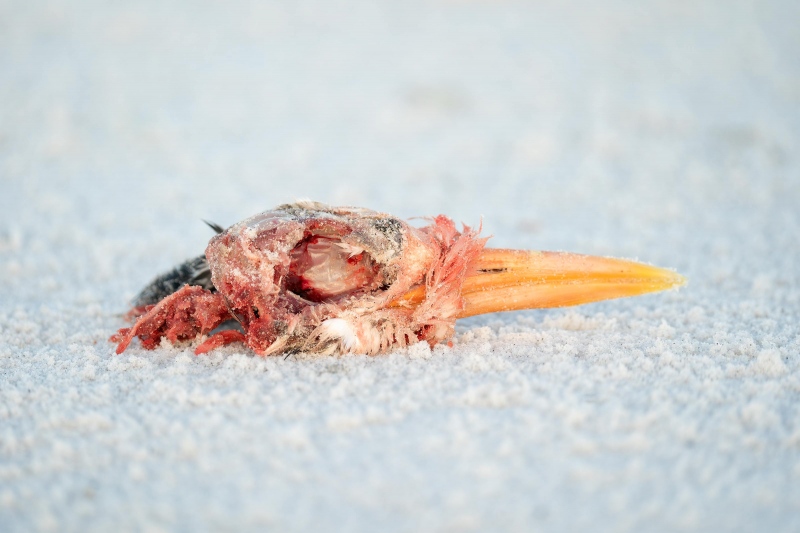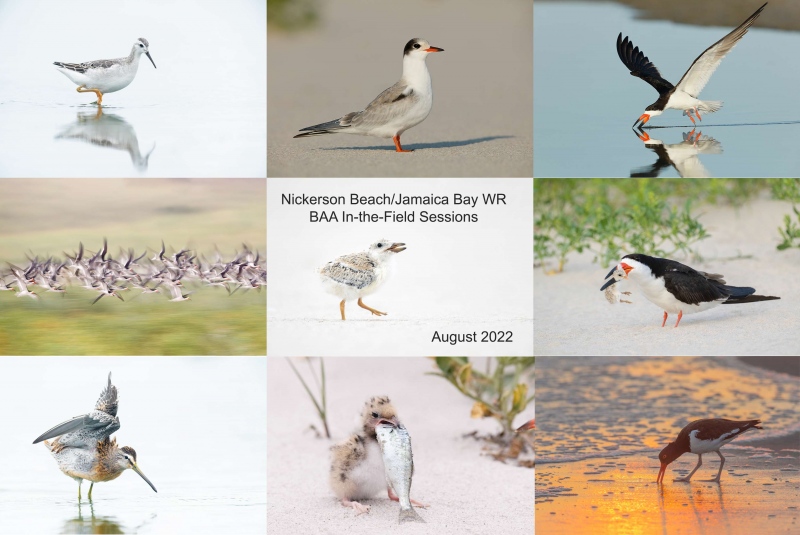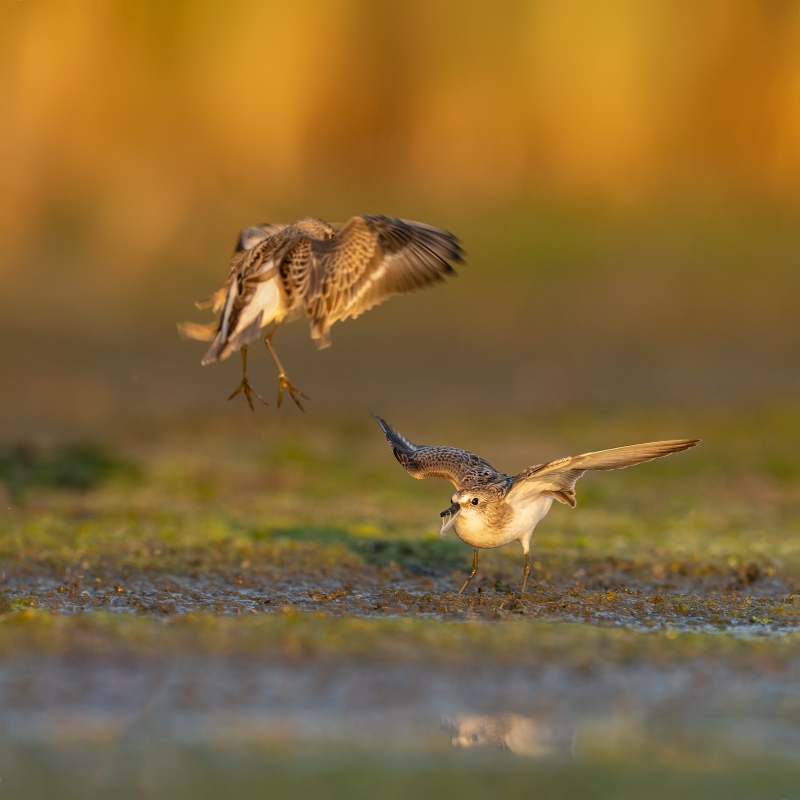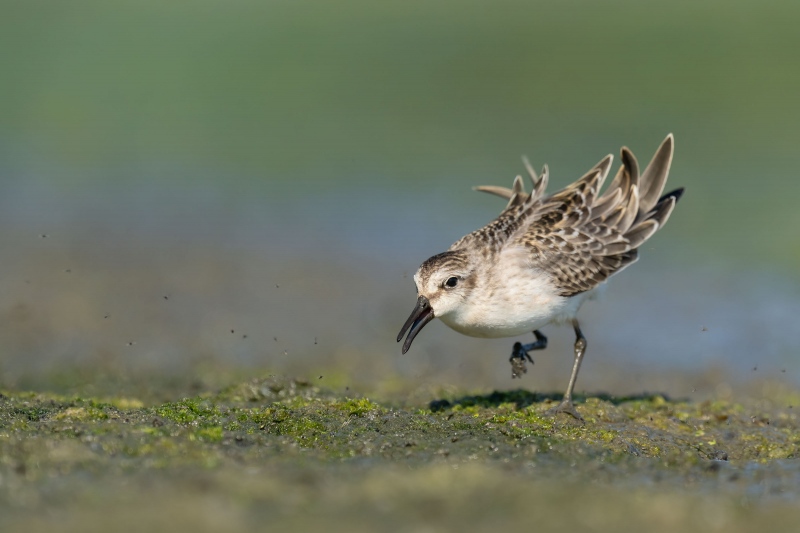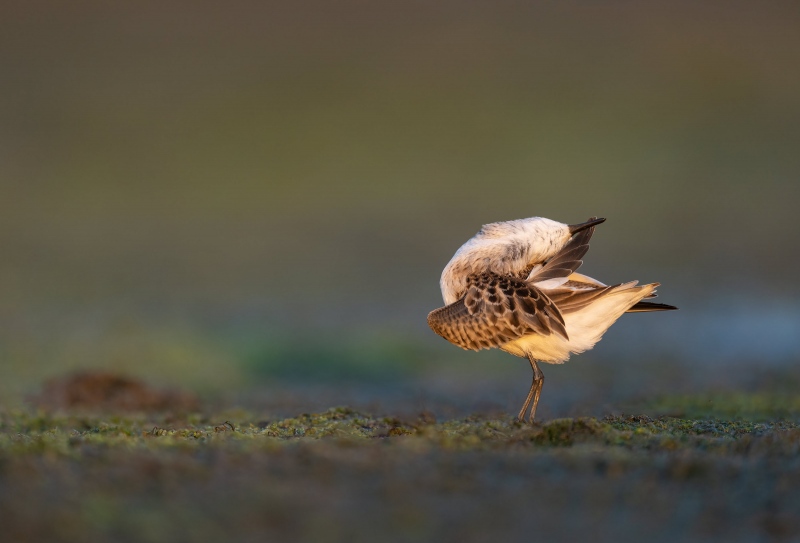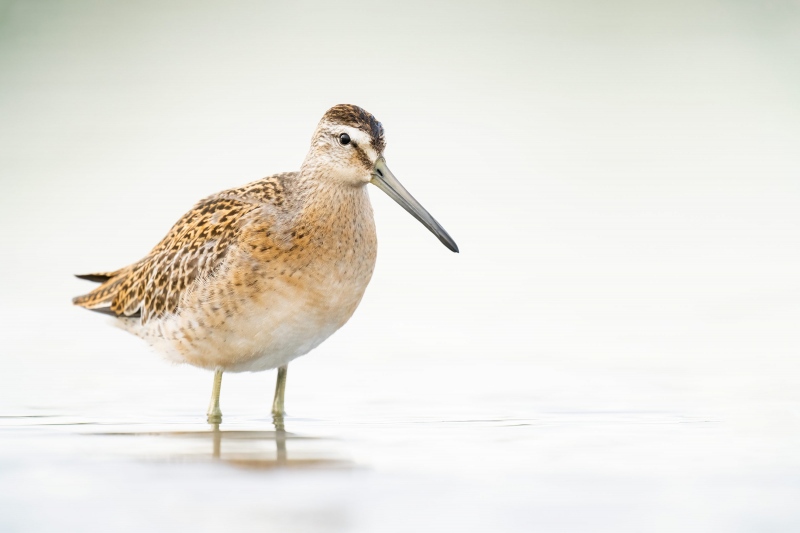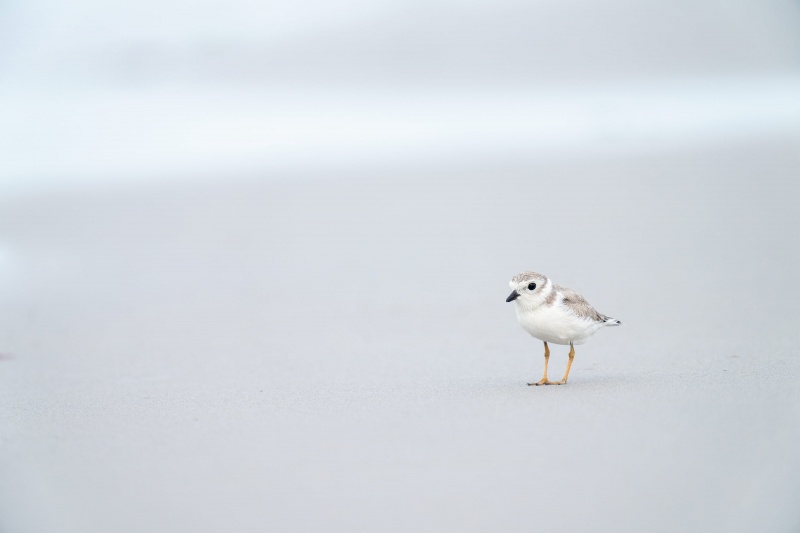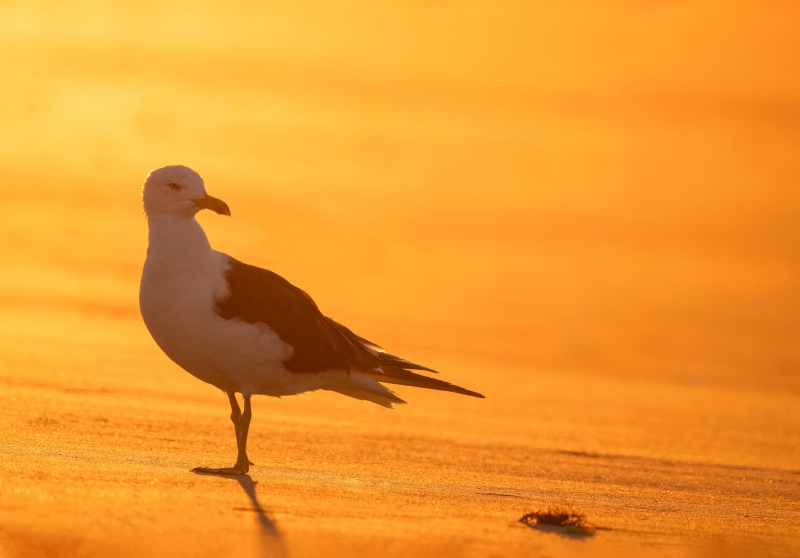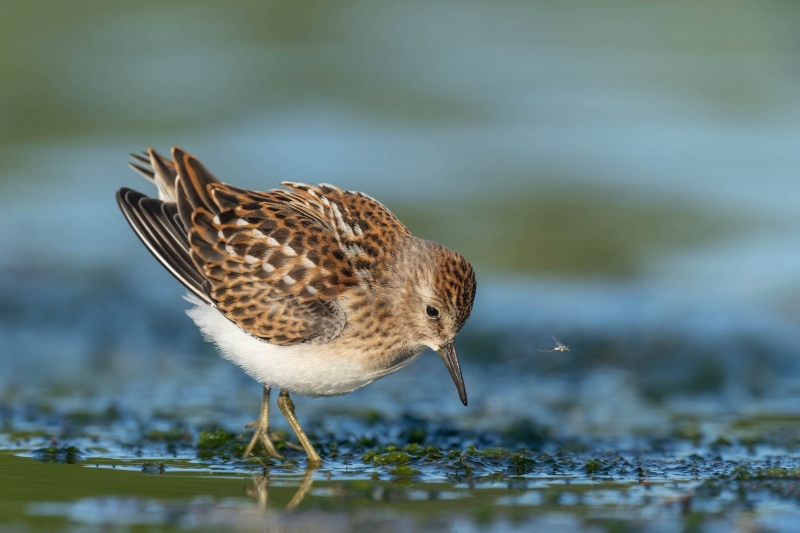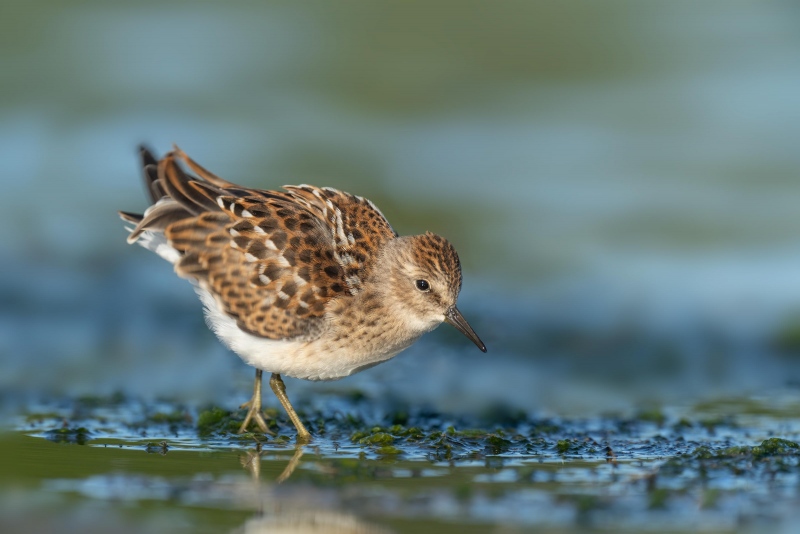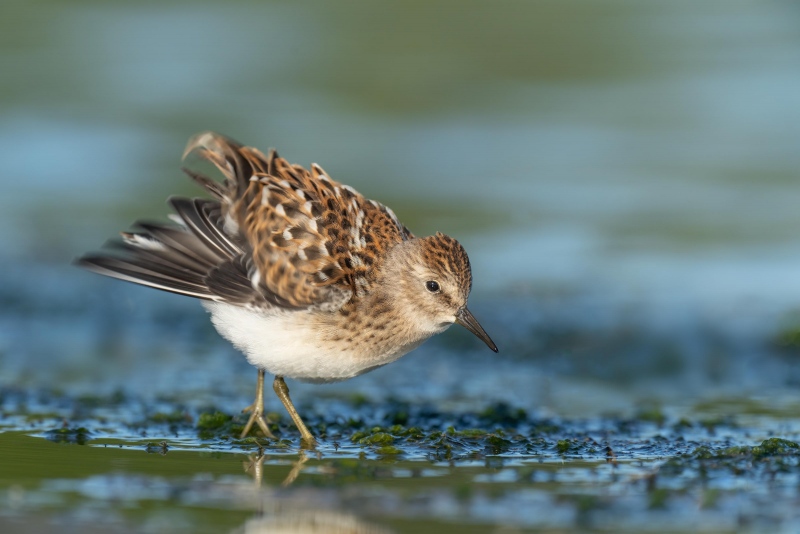August 27th, 2022 What’s Up?
On Friday morning at the East Pond, there were far fewer birds than there had been the day before. The small pond that held hundreds of birds the day before, held only a few individuals. The water level has continued to drop from evaporation. There has been no rain to speak of in about two months. The strange thing is that photography on Friday was a lot better than it had been on Thursday. Carlotta Grenier learned to shoot off the rear monitor with her tripod flattened. She did well and we had plenty of birds to photograph. At the Cross Bay Diner, I downloaded and installed both Photo Mechanic and RawDigger. Our “morning session” brunch ended at 1:20pm! On Monday, Carlotta will be returning for an afternoon workflow lesson followed by an In-the-Field session at Nickerson Beach. I head home on Wednesday and will be back in the office on Thursday at about lunchtime.
Friday afternoon turned out to be cloudy with thunderstorms so I am glad that I took the afternoon off. Today is Saturday 27 August 2022. With cloudy skies and a north wind in the forecast, I will head to the East Pond again this morning despite the 9:19am high tide. Wherever you are, and whatever you are doing, I hope that you too have a great day. This blog post took about an hour to prepare and makes one hundred fifty-five days in a row with a new one.
Please remember to use the B&H and Amazon links that are found on most blog pages and to use the BIRDSASART discount code at checkout when purchasing your new gear from Bedfords to get 3% back on your credit card and enjoy free second-day air FedEx. Please, also, consider joining a BAA IPT. You will be amazed at how much you will learn!
|
|
|
This image was created on 18 October 2020 on a Fall Fort DeSoto IPT. Siting on damp sand, I used the knee-pod technique with the hand held Sony FE 200-600mm f/5.6-6.3 G OSS lens (at 600mm) and The One, the Sony Alpha 1 Mirrorless digital camera. ) The exposure was determined using Zebra technology with ISO on the Thumb Dial. ISO 800. 1/400 second at f/6.3 (wide-open) in Manual Mode. AWB at7:55:06 am on a sunny morning. RawDigger showed the exposure to be perfect.
Tracking: Spot S AF-C with Bird Face/Eye Detection performed perfectly though there was no eyeball to be seen anywhere. Be sure to click on the image to enjoy a high-res version.
Royal Tern, dismembered head on sand
|
Suggestions for Improving this Image?
If you have any suggestions on how I could have improved this image either in the field or on the computer, please leave a comment.
Macabre: [muh-kah-bruh] adjective
1: gruesome and horrifying; ghastly; horrible.
2: of, pertaining to, dealing with, or representing death, especially its grimmer or uglier aspect.
3: suggestive of the allegorical dance of death.
This Royal Tern head likely belonged to a bird that was an early morning breakfast for a Peregrine Falcon. In a strange way, I find this image beautiful though macabre. What do you think?
Unsolicited via e-mail from Pete Myers
I just spent 4 days in the field in a graduate course in bird photography taught by Artie Morris at Fort DeSoto. After almost 50 years of experience pointing cameras at birds from the Arctic to Tierra del Fuego, New Zealand and beyond, I thought I was good enough. But what I learned from Artie in just four days has taken me to a whole new level. As he aptly puts it, “birds as art,” not simply bird photography. One of those 4 days was the most satisfying I’d ever experienced, anywhere. The IPT left me euphoric about what I’d learned, and frighteningly committed to recreating my portfolio with the techniques and insights he taught me.
|

|
|
Fort DeSoto in fall is rife with tame birds. All the images on this card were created at Fort DeSoto in either late September or very early October. I hope that you can join me there this fall. Click on the composite to enjoy a larger version.
Clockwise from upper left to center: Long-billed Curlew, Marbled Godwit, Caspian Tern, Great Egret, Sandwich Tern with fish, Willet, Black-bellied Plover threat display, Snowy Egret, 2-year old Yellow-Crowned Night-Heron, juvenile Yellow-Crowned Night-Heron.
|
The Fall 2022 Fort DeSoto Instructional Photo-Tours
Fall 2022 Fort DeSoto Instructional Photo-Tour #1
3 1/2 Days: Tuesday 27 September through the morning session on Friday 30 September 2022. $1899.00 includes three working lunches. Limit six photographers/Openings five.
Fall 2022 Fort DeSoto Instructional Photo-Tour #2
3 1/2 Days: 7 October through the morning session on Monday 10 October 2022. $1899.00 includes three working lunches. Limit six photographers.
Fall 2022 Fort DeSoto Instructional Photo-Tour #3
3 1/2 Days: Monday 31 October through the morning session on Thursday 3 November 2022. $1899.00 includes three working lunches. Limit six photographers.
Fort DeSoto, located just south of St. Petersburg, FL, is a mecca for migrant shorebirds and terns in fall. There they join hundreds of egrets, herons, night-herons, and gulls that winter on the T-shaped peninsula. With any luck at all, we should get to photograph one of Florida’s most desirable shorebird species: Marbled Godwit. Black-bellied Plover and Willet are easy, American Oystercatcher is pretty much guaranteed. Great Egret, Snowy Egret, Great Blue Heron, Tricolored Heron, and White Ibis are easy as well and we will almost surely come up with a tame Yellow-crowned Night-Heron or two. And we will get to do some Brown Pelican flight photography. In addition, Royal, Sandwich, Forster’s, and Caspian Terns will likely provide us with some good flight opportunities as well. Though not guaranteed, Roseate Spoonbill and Wood Stork might well be expected. And we will be on the lookout for a migrant passerine fallout in the event of a thunderstorm or two.
On this IPT, all will learn the basics and fine points of digital exposure. Nikon and Canon folks will learn to get the right exposure every time after making a single test exposure, and SONY folks will learn to use Zebras so that they can be sure of making excellent exposures before pressing the shutter button. Everyone will learn how to approach free and wild birds without disturbing them, to understand and predict bird behavior, to identify many species of shorebirds, to spot the good situations, to choose the best perspective, to see and understand the light, and to design pleasing images by mastering your camera’s AF system. Most importantly, you will surely learn to evaluate wind and sky conditions and understand how they affect bird photography. And you will learn how and why to work in Manual mode (even if you’re scared of it). The best news is that you will be able to take everything you learn home with you so that you will be a better photographer wherever and whenever you photograph.
There will be a Photoshop/image review session during or after lunch (included) each full day. That will be followed by Instructor Nap Time.
These IPTs will run with only a single registrant (though that is not unlikely to happen). The best airport is Tampa (TPA). Once you register, you will receive an e-mail with Gulfport AirBnB information. If you register soon and would like to share an AirBnB with me, shoot me an e-mail. Other possibilities including taking a cab to and from the airport to our AirBnB and riding with me. This saves you both gas and the cost of a rental car.
A $600 deposit is due when you sign up and is payable by credit card. Balances must be paid by check two months before the trip. Your deposit is non-refundable unless the IPT sells out with six folks, so please check your plans carefully before committing. You can register by calling Jim or Jennifer during weekday business hours at 863-692-0906 with a credit card in hand, or by sending a check as follows: make the check out to: BIRDS AS ART and send it via US mail here: BIRDS AS ART, PO BOX 7245, Indian Lake Estates, FL 33855. You will receive a confirmation e-mail with detailed instructions, clothing, and gear advice. Please shoot me an e-mail if you plan to register or if you have any questions.
|

|
|
Clockwise from upper left to center: Long-billed Curlew, juvenile Tricolored Heron, Marbled Godwits, Great Blue Heron, juvenile Pectoral Sandpiper, Wood Stork, smiling Sea Scallop, Ruddy Turnstone scavenging needlefish, Great Blue Heron sunset silhouette at my secret spot, and southbound migrant tern flock blur.
|
Up Early, Stay Out Late!
Obviously, folks attending an IPT will be out in the field early and stay late to take advantage of the sweetest light and sunrise and sunset colors (when possible). The good news is that the days are relatively short in early fall. I really love it when I am leaving the beach on a sunny morning after a great session just as a carful or two of well-rested photographers are arriving. The length of cloudy morning sessions will often be extended. Click on the composite to enjoy a larger version.
Typos
With all blog posts, feel free to e-mail or to leave a comment regarding any typos or errors.
August 26th, 2022 Which is the Strongest Image?
Why did you make your choice?
What’s Up?
Sandy Brown of Seattle and Sanjeev Nagrath of Chappaqua, NY enjoyed a fine Thursday morning at the East Pond. We had lots of shorebirds, mostly juveniles, some too close to focus. Our biggest problem as the tide rose in the surrounding bay was that it was hard to isolate individual birds because there were too many of them!. Sanjeev got to try out his brand new Cann RF 600mm f/4, the one he kindly purchased using my Bedfords discount code. He used it with both RF TCs and was thrilled to learn his new gear made very sharp images. For unknown reasons, I wound up getting much muddier than I had on previous visits.
I was glad to learn yesterday that Jim Miller’s Sony 100-400 GM lens sold on the first days of listing. His a7R IV is still up for grabs. It clouded over in the afternoon so I stayed in, relaxed, and went out for a nice dinner.
Today is Friday August 26 2022. I will be heading to JBWR to meet private client Carlotta Grenier for some fun in the mud at the East Pond. It will be her first visit ever to my soul place, the where my avian photography career effectively began 45 years ago (even though I did not have a telephoto lens until six years later, in 1983). Wherever you are, and whatever you are doing, I hope that you too have a great day. This blog post took about 90 minutes to prepare and makes one hundred fifty-four days in a row with a new one.
Please remember to use the B&H and Amazon links that are found on most blog pages and to use the BIRDSASART discount code at checkout when purchasing your new gear from Bedfords to get 3% back on your credit card and enjoy free second-day air FedEx. Please, also, consider joining a BAA IPT. You will be amazed at how much you will learn!
|
|
|
Clockwise from the upper left corner back around to the center: Wilson’s Phalarope, JBWR; just fledged Common Tern, Nickerson; Black Skimmer, adult skimming, Nickerson; Black Skimmer killing tiny skimmer chick, Nickerson; American Oystercatcher foraging at sunrise, Nickerson; Common Tern chick swallowing baby bluefish, Nickerson; Short-billed Dowitcher, juvenile, double overhead wing stretch, JBWR; Black Skimmers, predawn flock blur, Nickerson; Black Skimmer, 10-day old chick, Nickerson.
Click on the card to view a larger version.
Nickerson Beach/East Pond JBWR composite
|
Nickerson Beach/East Pond at Jamaica Bay (JBWR) In-the Field Workshops
Both Nickerson Beach and the East Pond at JBWR offer some of the best midsummer bird photography on the planet. Hundreds of pairs or Black Skimmers and Common Terns along with dozens of pairs of American Oystercatchers breed at Nickerson each season so there are lots of chicks of all sizes and handsome fledged young birds to photograph. Provided that the water levels are low, hundreds of young shorebirds in their handsome fresh juvenile plumages stop by the pond each August on their way south.
Nickerson often reveals nature at it rawest, most basic level. Most days we get to photograph all sorts of dramatic behaviors ranging from skimmers and terns fishing and feeding (and tending) their young. There are often chances to shoot a variety of predatory encounters — gulls eating large skimmer chicks, skimmers attacking (and sometimes killing) skimmer babies, and Peregrine Falcons hunting. And rarely, if we are lucky, Peregrine Falcons catching! Consider joining me to learn a ton both about bird photography and the birds.
I head south on 31 August and should be back home on 1 September (barring anything unforeseen). If you’d like to join me for and In-the-Field sessions at the East Pond on Saturday only or at Nickerson Beach on the 28, 29, or 30, please get in touch via e-mail or text me at 863-221-2372.
Instagram
Follow me on Instagram here. I am trying to feature both new and old images, especially images that have not appeared recently on the blog. Or search for birds_as_art.
BIRDS AS ART Image Optimization Service (BAA IOS)
Send a PayPal for $62.00 to birdsasart@verizon.net or call Jim at 863-692-0906 and put $62.00 on your credit card. Pick one of your best images and upload the raw file using a large file sending service like Hightail or DropBox and then send me the link via e-mail. I will download and save your raw file, evaluate the exposure and sharpness, and optimize the image as if it were my own after converting the raw file in Adobe Camera Raw. Best of all, I will make a screen recording of the entire process and send you a link to the video to download, save and study.
Induro GIT 304L Price Drop
Amazingly, we have two, brand-new-in-the-box Induro GIT 304L tripods in stock. They are $699.00 each (were $799.00) and the price now includes the insured ground shipping to the lower 48 states. Weekday phone orders only: 863-692-0906. Order yours here while they last.
Please Remember
You can find some great photo accessories (and necessities, like surf booties!) on Amazon by clicking on the Stuff tab on the orange/yellow menu bar above. On a related note, it would be extremely helpful if blog-folks who, like me, spend too much money on Amazon, would get in the habit of clicking on the Amazon logo link on the right side of each blog post when they shop online. As you might expect, doing so will not cost you a single penny, but would be appreciated tremendously by yours truly. And doing so works seamlessly with your Amazon Prime account.
Please remember that if an item — a Delkin flash card, or a tripod head — for example, that is available from B&H and/or Bedfords, is also available in the BAA Online Store, it would be great, and greatly appreciated, if you would opt to purchase from us. We will match any price. Please remember also to use my B&H affiliate links or to earn 3% cash back at Bedfords by using the BIRDSASART discount code at checkout for your major gear purchases. Doing either often earns you free guides and/or discounts. And always earns my great appreciation.
Brand-New and As-Good-As-Ever Bedfords BAA Discount Policy
Folks who have fallen in love with Bedfords can now use the BIRDSASART coupon code at checkout to enjoy a post-purchase, 3% off-statement credit (excluding taxes and shipping charges) on orders paid with a credit card. The 3% credit will be refunded to the card you used for your purchase. Be sure, also, to check the box for free shipping to enjoy free Second Day Air Fed-Ex. This offer does not apply to purchases of Classes, Gift Cards, or to any prior purchases.
Money Saving Reminder
Many have learned that if you need a hot photo item that is out of stock at B&H and would like to enjoy getting 3% back on your credit card along with free 2nd Day Air Fed-Ex Air shipping, your best bet is to click here, place an order with Bedfords, and enter the coupon code BIRDSASART at checkout. If an item is out of stock, contact Steve Elkins via e-mail or on his cell phone at (479) 381-2592 (Central time). Be sure to mention the BIRDSASART coupon code and check the box for Free Shipping. That will automatically upgrade to free 2nd Day Air Fed-Ex. Steve has been great at getting folks the hot items that are out of stock at B&H and everywhere else. The waitlists at the big stores can be a year or longer for the hard-to-get items. Steve will surely get you your gear long before that. For the past year, he has been helping BAA Blog folks get their hands on items like the SONY a 1, the SONY 200-600 G OSS lens, the Canon EOS R5, the Canon RF 100-500mm lens, and the Nikon 500mm PF. Steve is personable, helpful, and eager to please.
Important Note
As an Amazon Associate, I earn a small percentage when you purchase from Amazon after using any of the Amazon links on the blog (including the logo-link on the right side of each blog post page). My affiliate link works fine with Amazon Prime and using it will not cost you a single cent. Huge thanks, BTW 🙂
If You Enjoy the Blog …
Please, if you enjoy and learn from the blog, remember to use one of my two affiliate programs when purchasing new gear. Doing so just might make it possible for me to avoid having to try to get a job as a Walmart greeter and will not cost you a single penny more. And if you use Bedfords and remember to enter the BIRDSASART code at checkout, you will (still!) save 3% on every order and enjoy free second-day air shipping. In these crazy times — I lost about fifty thousand dollars in income due to COVID 19 — remembering to use my B&H link or to shop at Bedfords will help me out a ton and be greatly appreciated. Overseas folks who cannot order from the US because of import fees, duties, and taxes, are invited to help out by clicking here to leave a blog thank you gift if they see fit.


Gear Questions and Advice
Too many folks attending BAA IPTs and dozens of photographers whom I see in the field and on BPN, are–out of ignorance–using the wrong gear, especially when it comes to tripods and more especially, tripod heads… Please know that I am always glad to answer your gear questions via e-mail. If you are desperate, you can try me on my cell at 863-221-2372. Please leave a message and shoot me a text if I do not pick up.
|
|
|
This image was created on 24 August 2022 at the East Pond at Jamaica Bay Wildlife Refuge in Queens, NY. While seated on damp mud and working off the tilted rear screen, I used the flattened, no-longer available except from BIRDS AS ART, Induro GIT 304L tripod/Levered-Clamp FlexShooter Pro-mounted Sony FE 600mm f/4 GM OSS lens and The One, the Sony Alpha 1 Mirrorless digital camera. ISO 800. Exposure was determined via Zebras with ISO on the rear dial: 1/640 sec. at f/5 (stopped down 2/3 stop). AWB at 6:42:00am on a clear morning.
Tracking: Zone/AF-C was active at the moment of exposure and performed amazingly well. Be sure to click on the image to enjoy the larger version.
Image #1: Juvenile Least Sandpiper attacking juvenile Semipalmated Sandpiper
|
Striving for Different and Getting Lucky
Decent images of squabbling shorebirds are few and far between. Getting a decent fight shot with a relatively slow shutter speed of 1/640 second requires a bit of luck, as does framing such images when working low and off the rear monitor. I think that I was on the semi-sand when the leastie beastie flew in and instinctively pressed and held the the shutter button down. I’d rather be lucky than good any time. But both ain’t bad either.
The feather on the bill of the semi formerly resided on the breast of the young least. And I like the reflection of the face of the crouching semipalmated in the water.
|
|
|
This image was created on 24 August 2022 at the East Pond at Jamaica Bay Wildlife Refuge in Queens, NY. While seated on damp mud and working off the tilted rear screen, I used the flattened, no-longer available except from BIRDS AS ART, Induro GIT 304L tripod/Levered-Clamp FlexShooter Pro-mounted Sony FE 600mm f/4 GM OSS lens with the Sony FE 1.4x Teleconverter (at 840mm) with The One, the Sony a1 Mirrorless Camera. The exposure was determined via Zebras with ISO on the Thumb Wheel. ISO 800: 1/1600 sec. at f/6.3. AWB at 9:18:53am on a sunny morning.
Tracking: Zone/AF-C was active at the moment of exposure and performed amazingly well. Be sure to click on the image to enjoy the larger version.
Image #2: Juvenile Semipalmated Sandpiper charging
|
Relatively Cold Light
As we saw here several days ago, the color temperature of the light after 9am on sunny days is a lot cooler than the color temperature of the light at 6:30am on a clear morning. In Image #2, the light is relatively cold — there are no warm tones; the BLUE tones predominate. The higher the sun is in the sky, the more the RED and YELLOW light is blocked. As seen in Image #3 below, the warm early morning light is much richer in YELLOWs and REDs.
You can prove this to yourself as follows. In the adjusted raw file for #2, the RGB values for the brightest WHITEs on the bird’s forehead are R = 253, G = 253, B = 252. The RED value is just one point higher than the BLUE value. For Image #3, below, the RGB values for the brightest WHITEs of the adjusted raw file on the bird’s forehead are R = 249, G = 234, B = 220. The R values is 29 points higher for RED than for BLUE. The greater the difference between the REDs and the BLUEs, the warmer and more golden the light.
|
|
|
This image was created on 25 August 2022 at the East Pond at Jamaica Bay Wildlife Refuge in Queens, NY. While seated on damp mud and working off the tilted rear screen, I used the flattened, no-longer available except from BIRDS AS ART, Induro GIT 304L tripod/Levered-Clamp FlexShooter Pro-mounted Sony FE 600mm f/4 GM OSS lens and The One, the Sony Alpha 1 Mirrorless digital camera. ISO 1600. Exposure was determined via Zebras with ISO on the rear dial: 1/1250 sec. at f/4 (wide open). AWB at 6:38:08am on a clear morning.
Tracking: Zone/AF-C was active at the moment of exposure and performed perfectly,. Be sure to click on the image to enjoy the larger version.
Image #3: Juvenile Semipalmated Sandpiper preening
|
Give Me 90 Good Seconds
In very early morning light, the 1.4X TC remains in my fanny pouch so that I can work wide open at f/4. Here, I opted for the relatively fast shutter speed of 1/1250 second in case a fight broke out. This bird walked right in front of me just to the right of my shadow and began preening. In about 90 seconds I created 267 images of the handsome young semi. So far, I have kept only eighteen. Most will hit the dust as I re-edit the folder. Image #3 was one of my favorites. Each of the 267 images in the series was different and distinct.
Typos
With all blog posts, feel free to e-mail or to leave a comment regarding any typos or errors.
August 25th, 2022 Which of Today’s Six Featured Images is Your Favorite?
Why?
What’s Up?
Wednesday morning at JBWR was decent with fewer bugs and some nice cool air. The NW breeze freshened as the morning went on eliminating the mosquitoes but making photography more difficult. A strong onshore breeze at Nickerson in the afternoon made things fun, especially with midair skimmer battles. And several very late Black Skimmer nests hatched near the ropes so there are a few tiny chicks around.
Today is Thursday 25 August 2022. The forecast for the morning is a carbon copy of yesterday’s. I will be heading back to the East Pond very early. Wherever you are, and whatever you are doing, I hope that you too have a great day. This blog post took about 90 minutes to prepare and makes one hundred fifty-three days in a row with a new one.
Please remember to use the B&H and Amazon links that are found on most blog pages and to use the BIRDSASART discount code at checkout when purchasing your new gear from Bedfords to get 3% back on your credit card and enjoy free second-day air FedEx. Please, also, consider joining a BAA IPT. You will be amazed at how much you will learn!
Selling Your Used Photo Gear Through BIRDS AS ART
Selling your used (or like-new) photo gear through the BAA Blog is a great idea. We charge only a 5% commission on items priced at $1,000 or more. With items less than $1000, there is a $50 flat-fee. One of the more popular used gear for sale sites charged a minimum of 20%. Plus assorted fees! Yikes. They went out of business. And e-Bay fees are now up to 13%. If you are interested, please click here, read everything carefully, and do what it says. To avoid any misunderstandings, please read the whole thing very carefully. If you agree to the terms, please state so clearly via e-mail and include the template or templates, one for each item you wish to sell. Then we can work together to get your stuff priced and listed.
Stuff that is priced fairly — I offer pricing advice only to those who agree to the terms — usually sells in no time flat. Over the past years, we have sold many hundreds of items. Do know that prices for used gear only go in one direction. Down. You can always see the current listings by clicking here or on the Used Photo Gear tab on the orange-yellow menu bar near the top of each blog post page.
Sony a7RIV Full Frame Mirrorless Body
BAA Record-low Price!
Multiple IPT veteran Jim Miller is offering a Sony a7RIV Full Frame Mirrorless body in excellent plus to near mint condition for a BIRDS AS ART record-low $1897.00. The sale includes the original box, all manuals and documents, the front body cap, one battery and the charger with power cord, the USB-C/USB cable, the original product box, and insured ground shipping via major courier to lower-48 US addresses only. Your item will not ship until your check clears unless other arrangements are made.
Please contact Jim via e-mailor by phone at 850-445-5042 (Eastern time zone).
For the past several years you have seen the incredible detail in my a7r IV images made with a variety of SONY lenses and both teleconverters. Before the a1, I typically used my 7r IV for about 50% of my bird photography and my a9 II in pure flight situations. As the a7r IVA sells new right now for $3498.00 (and the only “improvement” over the original a7R IV is more resolution in the rear monitor), you can save a cool $1601.00 by grabbing Jim’s sweet a7r IV ASAP. Though this 61-MP body is especially attractive to landscape and macro photographers, it is great for birds as well; you can pretty much crop to your heart’s content. For photographing bird in flight, I do not recommend its use with the 200-600 G lens. artie
Sony G Master FE 100-400mm F/4.5-5.6 GM OSS Lens
BAA Record-low Price!
Jim Miller is offering a Sony G Master FE 100-400mm F/4.5-5.6 GM OSS lens in near-mint condition for a BIRDS AS ART record-low $1296.00. The sale includes the the original product box, the manuals, the front and rear lens caps, the nylon zippered case, the hood, the lens strap, and insured ground shipping via major courier to lower-48 US addresses only. Your item will not ship until your check clears unless other arrangements are made.
Please contact Jim via e-mailor by phone at 850-445-5042 (Eastern time zone).
This versatile, mega-close-focusing lens is easily hand holdable by most folks; it is much lighter than the 200-600 G lens. It is great for bird photography. I used mine often for flight photography, for head shots of silly-tame birds, and for large flowers, butterflies, frogs, and the like. It sells new for $2498.00 so you can save a handsome $1,2002 by grabbing Mark’s Jim’s lens today. artie
|
|
|
This image was also created on 21 August on an In-the-Field session at the north end of the East Pond at JBWR, Queens, NY. Again, while seated on damp mud and working off the titled rear monitor, I used the flattened, no-longer available except from BIRDS AS ART, Induro GIT 304L tripod/Levered-Clamp FlexShooter Pro-mounted Sony FE 600mm f/4 GM OSS lens, the Sony FE 2.0x Teleconverter (at 1200mm) and The One, the Sony Alpha 1 Mirrorless Digital Camera). Shutter Priority at zero. The exposure was determined via Zebra technology with Exposure Compensation on the thumb dial. AUTO ISO set ISO 4000. 1/500 sec. at f/8 (wide open). When evaluated in RawDigger, it was determined that the raw file exposure was shown to be dead-solid perfect. AWB at 6:26:54am on a then very cloudy, dark afternoon.
Tracking: Zone/AF-C with Bird-Eye/Face Detection performed perfectly. Be sure to click on the image to enjoy a high-res version.
Image #1A: Bright juvenile plumage Short-billed Dowitcher
|
Odd Man Out
In the North End East Pond on a Bad Afternoon – Fun in the Dark! blog post here, my favorite of the four images was Image #3, the juvie Short-billed Dowitcher, now #1A, above. Why? Many shorebirds in fresh juvenal plumage have an orange blush on their breasts. This blush wears quickly as juvenile feathers wear more quickly than adult feathers. Had the yellowlegs image been razor sharp, I would have chosen that one as best.
|
|
|
This image was also created on 20 August 2022 at Nickerson Beach Park, Lido Beach, Long Island, NY. While seated on damp sand, I used the lowered, no-longer available except from BIRDS AS ART, Induro GIT 304L tripod/Levered-Clamp FlexShooter Pro-mounted Sony FE 600mm f/4 GM OSS lens with the Sony FE 1.4x Teleconverter (at 840mm) with The One, the Sony a1 Mirrorless Camera. The exposure was determined via Zebras with ISO on the Thumb Wheel. ISO 2000: 1/800 sec. at f/5.6. AWB at 7:30:06am on a cloudy morning.
Tracking: Zone/AF-C with Bird Face/Eye detection enabled was active at the moment of exposure and performed perfectly. Be sure to click on the image to enjoy the larger version.
Image #2A: Small in the big world juvenile Piping Plover
|
Small in the big world juvenile Piping Plover
In the Piping Plover Thanks to Muhammad Arif (AKA Moe) blog post here, my favorite image by a small margin was Image #2 (now #2A, above). I love the concept of placing small-in-the-frame, vulnerable subjects in large expanses of habitat. And I just love the clean wet sand left by receding tides (or waves). A close second for me was the PIPL with the worm. The standoff image was exciting to see and make, but the head angles were less than perfect.
|
|
|
This image was created on 19 August 2022 at Nickerson Beach Park, Lido Beach, Long Island, NY. While seated on damp sand, I used the hand held Sony FE 200-600mm f/5.6-6.3 G OSS lens with the Sony FE 1.4x Teleconverter (at 840mm)) and The One, the Sony Alpha 1 Mirrorless digital camera. ) The exposure was determined using Zebra technology with Exposure Compensation on the Thumb Dial. Shutter Priority + 1.3-stops. Auto ISO set ISO 500. 1/500 sec. at f/6.3 (wide open). AWB at 6:24:23am just after sunrise. RawDigger showed the exposure to be dead-solid perfect.
Tracking: Spot S — AF-C with Bird Face/Eye Detection performed perfectly. Be sure to click on the image to enjoy a high-res version.
Image #3A: Lesser Black-backed Gull backlit at sunrise
|
Understanding the Qualities of Light
In the Understanding the Ever-changing Qualities of Light. And Working What Used to Be a Very Rare Gull blog post here, all but the comparative id image of the Great Black-backed Gull received mentions. I agree as the other five were all strong photos. For me the two best are the elegant #5, and #4 — now #3A, above), the Lesser Black-backed Gull backlit at sunrise image. If you twisted my arm, I’d go with the backlit sunrise image.
In the same post, I wrote:
Note the quality of the light at nine in the morning (Image #1), and compare it with the quality of light in Images # 4, 5, and 6, those all made before seven am on a sunny morning. What differences are you seeing?
Nobody took a crack at that one. The WHITEs in Image #1 are much colder with more BLUE in them than the WHITEs in the images made before 7am. Those feature more warm tones, the YELLOWs and the REDs. When we process the images, we strive to make the colder toned images a bit warmer and the warmer tones images a bit cooler (while retaining the look of the image as it was captured).
|
|
|
This image was also created on 13 August 2022 at the East Pond at Jamaica Bay Wildlife Refuge in Queens, NY. While seated on damp mud and working off the tilted rear monitor, I used the flattened, no-longer available except from BIRDS AS ART, Induro GIT 304L tripod/Levered-Clamp FlexShooter Pro-mounted Sony FE 600mm f/4 GM OSS lens with the Sony FE 1.4x Teleconverter (at 840mm) with The One, the Sony a1 Mirrorless Camera. The exposure was determined via Zebras with ISO on the Thumb Wheel. ISO 800: 1/1000 sec. at f/8. AWB at 7:59:39 on a sunny morning.
Tracking: Zone/AF-C with Bird Face/Eye detection enabled was active at the moment of exposure and performed perfectly. Be sure to click on the image to enjoy the larger version.
Image #1: Least Sandpiper juvenile looking for prey (with small flying insect)
|
The First Frame
The Least Sandpiper landed to our left and foraged right toward sun angle. This was the first keeper in a two-second series. I am absolutely over-the-moon about the sharp flying insect.
|
|
|
This image was also created on 13 August 2022 at the East Pond at Jamaica Bay Wildlife Refuge in Queens, NY. While seated on damp mud and working off the tilted rear monitor, I used the flattened, no-longer available except from BIRDS AS ART, Induro GIT 304L tripod/Levered-Clamp FlexShooter Pro-mounted Sony FE 600mm f/4 GM OSS lens with the Sony FE 1.4x Teleconverter (at 840mm) with The One, the Sony a1 Mirrorless Camera. The exposure was determined via Zebras with ISO on the Thumb Wheel. ISO 800: 1/1000 sec. at f/8. AWB at 7:59:40am on a sunny morning.
Tracking: Zone/AF-C with Bird Face/Eye detection enabled was active at the moment of exposure and performed perfectly. Be sure to click on the image to enjoy the larger version.
Image #2: Least Sandpiper juvenile ruffling version I
|
The First Keeper from the Second Second
When the bird was right on sun angle, it ruffled its feathers, I held the shutter button down for a ten-frame burst. I kept two. I love each of them.
|
|
|
This image was also created on 13 August 2022 at the East Pond at Jamaica Bay Wildlife Refuge in Queens, NY. While seated on damp mud and working off the tilted rear monitor, I used the flattened, no-longer available except from BIRDS AS ART, Induro GIT 304L tripod/Levered-Clamp FlexShooter Pro-mounted Sony FE 600mm f/4 GM OSS lens with the Sony FE 1.4x Teleconverter (at 840mm) with The One, the Sony a1 Mirrorless Camera. The exposure was determined via Zebras with ISO on the Thumb Wheel. ISO 800: 1/1000 sec. at f/8. AWB at 7:59:40am on a sunny morning.
Tracking: Zone/AF-C with Bird Face/Eye detection enabled was active at the moment of exposure and performed perfectly. Be sure to click on the image to enjoy the larger version.
Image #3: Least Sandpiper juvenile ruffling version II
|
Why f/8?
As regular readers know, I usually work at the wide open aperture with the 600mm f/4 and the 1.4X TC. For all three of the juvie Least Sandpiper images above, I stopped down one full stop to f/8. Why? For just a tiny increase in depth of field to sharpen the face up a bit.
Understand that when working at point blank range with long effective focal lengths, depth-of-field is razor thin. PhotoPills shows that at f/5.6, dof in front and in back of the point of focus is effectively zero! At f/8, the total dof is .01 meters, 4/10 of a single inch, just 2/10 of an inch (less than 1/4 inch) in front of and behind the subject.
If you would like to learn when getting the legs and the feathers are the rear of the bird sharp is a ridiculous idea, check out my comments on the BPN thread here.
The Three Best From a Great East Pond Jamaica Bay Wildlife Refuge Morning — give me two good seconds!
In the The Three Best From a Great East Pond Jamaica Bay Wildlife Refuge Morning — give me two good seconds! blog post here, I like all three images equally — I could not pick a single favorite. Images #2 and #3 clearly offered a better look at the face of the tiny sandpiper, but the bird’s intent stare and the sharp tiny flying insect in #1 were very special. Choosing between the two ruffling images, #2 and #3, was equally difficult. While I liked the great view of the folded wing in Image #2, I loved seeing the spread primary feathers in Image #3.
Typos
With all blog posts, feel free to e-mail or to leave a comment regarding any typos or errors.
|
|

